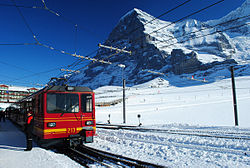Jungfrau railway
| Jungfrau railway | |||
|---|---|---|---|

|
|||
| Overview | |||
| Locale | Bern/Valais, Switzerland | ||
| Technical | |||
| Line length | 9.3 km (5.8 mi) | ||
| Track gauge | 1 Metre (3 ft 3 3⁄8 in) | ||
| Minimum radius | 100 m | ||
| Electrification | 3-phase, 1,125 V, 50 Hz | ||
| Highest elevation | 3,454 m (11,332 ft) | ||
| Maximum incline | 25 % | ||
| Rack system | Strub | ||
|
|||
The Jungfrau railway (German: Jungfraubahn, JB) is a metre gauge (3 ft 3 3⁄8 in gauge) rack railway which runs 9 kilometres (5.6 mi) from Kleine Scheidegg to the highest railway station in Europe at Jungfraujoch (3,454 m), between the Bernese Oberland and Valais in Switzerland. The railway runs almost entirely within the Jungfrau Tunnel, built into the Eiger and Mönch mountains and containing two stations in the middle of the tunnel, where passengers can disembark to observe the neighbouring mountains through windows built into the mountainside. The initial open-air section culminates at Eigergletscher (2,320 m), which makes it the second highest open-air railway in Switzerland. The line is electrified at 3-phase 1,125 volts 50 Hertz, and is one of four lines in the world using three-phase electric power.
At Kleine Scheidegg the JB connects with the Wengernalpbahn (WAB), which has two routes down the mountain, running respectively to the villages of Lauterbrunnen and Grindelwald. From both villages, branches of the Berner Oberland Bahn (BOB) connect to the Swiss Federal Railways at Interlaken.
...
Wikipedia
